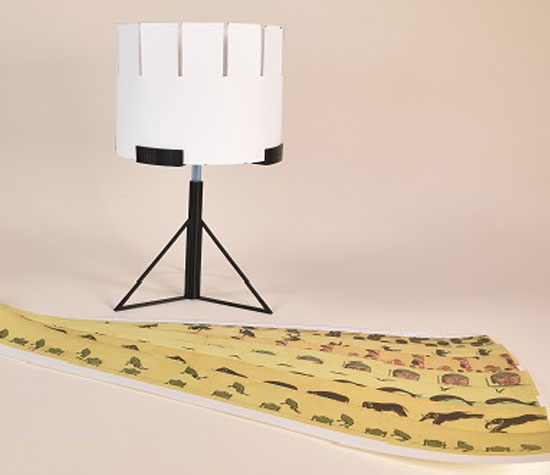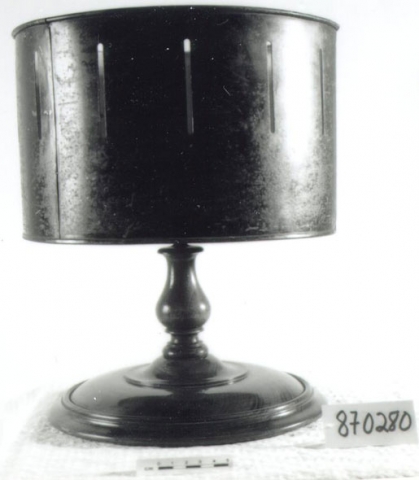Zoetrope

Zoetrope and zoetrope strips, Ingenium

Zoetrope and zoetrope strips, Ingenium
How does this align with my curriculum?
Zoetropes are an early form of animation technology. Learn about this Ingenium artifact and make your own version of this artifact using 3D printing!
These activities are based on artifacts from Ingenium - Canada's Museums of Science and Innovation.
Artifact no. 1987.0280.001 (Zoetrope); 1987.0281.001 (Zoetrope strip)
What is a Zoetrope?
Zoetropes are an early form of animation technology. A zoetrope is made up of a cylinder with slits cut vertically in the sides. There is a row of images on the inside of the cylinder. The images are sequential. This means the scene in each image follows the scene in the image before it.
When a person looks through a zoetrope, they spin it by hand. The viewer looks through the slits. The images rotate quickly inside the cylinder. Because the images are sequential, they appear to be moving!
When were Zoetropes invented?
The first device of this type was invented in 1834. It was invented by a mathematician named William Horner. He named it a Daedalum. People nicknamed it the “Wheel of the Devil”. Later zoetropes had slits above the images. But Horner’s drum had slits between the images. The technology was forgotten for many years. But it was rediscovered in 1867. That year, an American called William Lincoln patented the name Zoetrope. Soon after, the board game company Milton Bradley began selling the zoetrope. By 1868, the company had 73 different strips for sale!
What other technologies did Zoetropes lead to?
Zoetropes were followed by other devices. For example, the praxinoscope and flip books came next. Both of these give the illusion of moving pictures. The basic principles behind the zoetrope were also used to create motion pictures. The visual effects created by zoetropes are still used today. For example, they are used to create animated GIFs. They are also used in video display technologies such as streaming video.
Starting Points
- Have you ever seen or used a zoetrope? If so where? (e.g., in movie, a museum display, etc.)
- What sort of image would you animate if you made a zoetrope?
- What do you think it was like to see a zoetrope in action for the first time?
- The zoetrope was a popular Victorian era parlour toy. What other toys and games were popular during this period (1837-1901) (will require additional research)?
- In what way did toys like the zoetrope make modern cinema and animation possible?
- Create a timeline of animation devices from the flipbook and thaumatrope to modern stop motion technology.
- Find out why this device is called a “zoetrope.”(The word zoetrope is based on Greek words zoe meaning ‘life’ and tropos meaning ‘to turn.’)
- How are concepts related to optics and the human brain applied to the construction of a zoetrope?
- How does the speed of spinning the cylinder effect how the images appear to be moving? (The faster the spinning, the smoother the apparent motion of images.)
- Why are the slits in the cylinder important? What role do they play in viewing the images?
- Compare and contrast a zoetrope with a praxinoscope. How do they use optics in similar and different ways?
- Explain how ‘persistence of vision’ and ‘beta movement’ allows us to believe that a series of still images are moving.
- Find a way to make the cylinder spin without using your hands (e.g., put on a record turntable, wind a string around the shaft and pull, add fins to the outside of the cylinder and use a fan to push, etc.)
- Which communication devices led to the end of the zoetrope? (the praxinoscope (1887), photographic film (1889), moving pictures (1895))
- 3D print one copy of the artifact at its original size and shape. Modify the length of the arms which hold the paper cylinder on the STL file and print the artifact again. Put a paper zoetrope strip on each one and spin. How does the radius of the cylinder affect how the images appear? How does the paper zoetrope strip need to be modified to match the length of the arms?
- Instead of using images on a paper strip, design and 3D print a series of objects that can be attached to the inside of the cylinder or made part of the cylinder itself (e.g., like this LEGO Zeotrope).
- Ingenium has instructions for building a zoetrope, as well as instructions and templates for making your own zoetrope strips. Follow the links below for more information:
Connecting and Relating
- Have you ever seen or used a zoetrope? If so where? (e.g., in movie, a museum display, etc.)
- What sort of image would you animate if you made a zoetrope?
- What do you think it was like to see a zoetrope in action for the first time?
Historical Significance
- The zoetrope was a popular Victorian era parlour toy. What other toys and games were popular during this period (1837-1901) (will require additional research)?
- In what way did toys like the zoetrope make modern cinema and animation possible?
- Create a timeline of animation devices from the flipbook and thaumatrope to modern stop motion technology.
Relating Science and Technology to Society and the Environment
- Find out why this device is called a “zoetrope.”(The word zoetrope is based on Greek words zoe meaning ‘life’ and tropos meaning ‘to turn.’)
- How are concepts related to optics and the human brain applied to the construction of a zoetrope?
Exploring Concepts
- How does the speed of spinning the cylinder effect how the images appear to be moving? (The faster the spinning, the smoother the apparent motion of images.)
- Why are the slits in the cylinder important? What role do they play in viewing the images?
- Compare and contrast a zoetrope with a praxinoscope. How do they use optics in similar and different ways?
- Explain how ‘persistence of vision’ and ‘beta movement’ allows us to believe that a series of still images are moving.
Nature of Technology
- Find a way to make the cylinder spin without using your hands (e.g., put on a record turntable, wind a string around the shaft and pull, add fins to the outside of the cylinder and use a fan to push, etc.)
- Which communication devices led to the end of the zoetrope? (the praxinoscope (1887), photographic film (1889), moving pictures (1895))
Teaching Suggestions
- 3D print one copy of the artifact at its original size and shape. Modify the length of the arms which hold the paper cylinder on the STL file and print the artifact again. Put a paper zoetrope strip on each one and spin. How does the radius of the cylinder affect how the images appear? How does the paper zoetrope strip need to be modified to match the length of the arms?
- Instead of using images on a paper strip, design and 3D print a series of objects that can be attached to the inside of the cylinder or made part of the cylinder itself (e.g., like this LEGO Zeotrope).
- Ingenium has instructions for building a zoetrope, as well as instructions and templates for making your own zoetrope strips. Follow the links below for more information:
